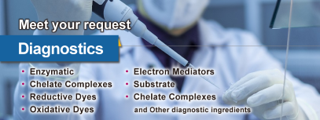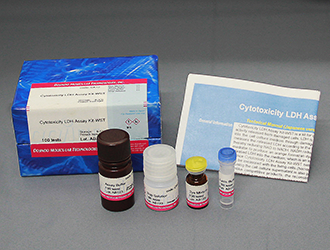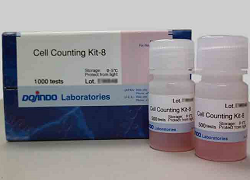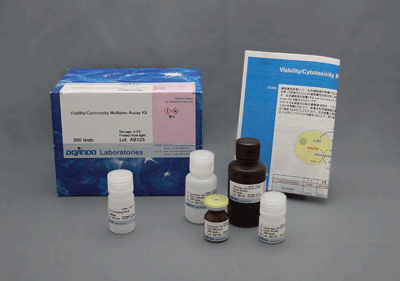WST-1
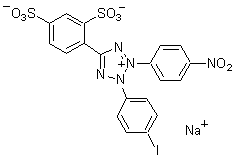
Reductive Chromogenic Dye
-
Product codeW201 WST-1
-
CAS No.150849-52-8
-
Chemical name2-(4-Iodophenyl)-3-(4-nitrophenyl)-5-(2,4-disulfophenyl)-2H-tetrazolium, monosodium salt
-
MWC19H11IN5NaO8S2=651.35
| Unit size | Price | Item Code |
|---|---|---|
| 100 mg | Find your distributors | W201-10 |
| 500 mg | Find your distributors | W201-12 |
Oxidation Reaction

Product Description of WSTs
Water-soluble tetrazolium salts (WSTs) were developed by introducing positive or negative charges and hydroxy groups to the phenyl ring of the tetrazolium salt. Positive charges, such as trialkylammonio groups, improve the water-solubility of the formazan dye. However, a large cation is easily precipitated out with organic anions such as carboxylate or phosphate. Although a hydroxy group also improved the
water solubility of the tetrazolium salt, the corresponding formazan dye was not sufficiently water-soluble. Dojindo’s WSTs have sulfonate groups added directly or indirectly to the phenyl ring to improve water-solubility. Dojindo also offers several newly developed phenylazotype tetrazolium salts, which are easily reduced with NADH or other reducing agents to give orange or purple formazan dyes. Due to the phenylazo group, the color changes with heavy metal ion. Since the water solubility of Dojindo’s WSTs is high, 10 mM to 100 mM solutions can be prepared.
Technical info

Fig 2 Absorption Spectra of WST Formazan Dyes
References
1) M. Ishiyama, M. Shiga, K. Sakamoto, M. Mizoguchi and Pin-Gang He, "A New Sulfonated Tetrazolium Salt That produces a Highly Water-soluble Formazan Dye", Chem. Pharm. Bull., 1993, 41, 1118.
2) T. Yano, K. Teruya, S. Shirahata, J. Watanabe, K. Osada, H. Tachibana, H. Ohashi, Eun-Ho Kim and H. Murakami, "Ras Oncogene Enhances the Production of a Recombinant Protein Regulated by the Cytomegalovirus Promoter in BHK-21 Cells", Cytotechnology, 1994, 16, 167.
3) K. Teruya, T. Yano, S. Shirahata, J. Watanabe, K. Osada, H. Ohashi, H. Tachibana, Eun-Ho Kim and H. Murakami, "Ras Amplification in BHK-21 Cells Produces a Host Cell Line for Further Rapid Establishment of Recombiant Protein Hyper-producing Cell Lines", Biosci. Biotech. Biochem., 1995, 59, 341.
4) M. Ishiyama, K. Sasamoto, M. Shiga, Y. Ohkura and K. Ueno, "Novel Disulfonated Tetrazolium Salt That can be Reduced to a Water-soluble Formazan and Its Application to the Assay of Lactate Dehydrogenase", Analyst, 1995, 120, 113.
5) M. Ishiyama, H. Tominaga, M. Shiga, K. Sasamoto, Y. Ohkura, K. Ueno and M. Watanabe, "Novel Cell Proliferation and Cytotoxicity Assays Using a Tetrazolium Salt That Produces a Water-soluble Formazan Dye", In Vitro Toxicology, 1995, 8, 187.
6) S. Q. Liu, K. Saijo, T. Todoroki and T. Ohno, "Induction of Human Autologous Cytotoxic T Lymphocytes on Formalin-Fixed and Paraffin-Embedded Tumour Sections", Nature Med., 1995, 1(3), 267.
7) T. Takenouchi and E. Munekata, "Trophic Effects of Substance P and β-Amyloid Peptide on Dibutyryl Cyclic AMP-Differentiated Human Leukemic (HL-60) Cells", Life Sci., 1995, 56, 479.
8) T. Iwaki, A. Iwaki, Y. Fukumaki and J. Tateishi, "β-Crystallin in C6 Glioma Cells Supports their Survival in Elevated Extracellular K+: the Implication of a Protective Role of β-Crystallin Accumulation in Reactive Glia", Brain Res., 1995, 673, 47.
9) M. Ishiyama, H. Tominaga, M. Shiga, K. Sasamoto, Y. Ohkura and K. Ueno, "A Combined Assay of Cell Viability and vitro Cytotoxycity with a Highly Water-soluble Tetrazolium Salt, Neutral Red and Crystal Violet", Biol. Pharm. Bul., 1996, 19, 1518.
10) T. Mosmann, "Rapid Colorimetric Assay for Cellular Growth and Survival: Application to Proliferation and Cytotoxicity Assays", J. Immunol. Methods, 1983, 65, 55.
11) A. H. Cory, T. C. Owen, J. A. Barltrop and J. G. Cory, "Use of an Aqueous Soluble Tetrazolium/Formazan Assay for Cell Growth Assays in Culture", Cancer Commun., 1991, 3, 207.
12) N. W. Roehm, G. H. Rodgers, S. M. Hatfield and A. L. Glasebrook, "An Improved Colorimetric Assay for Cell Proliferation and Viability Utilizing the Tetrazolium Salt XTT", J. Immunol. Methods, 1991, 142, 257.
Handling and storage condition
| Appearance: | Pale yellow to yellowish brown powder |
|---|---|
| Solubility in water: | To pass test (clear, pale yellow to yellowish brown) |
| Molar absorptivity: | ≧ 21,600 (around 244 nm) |
| Water content: | ≦ 6.0 % |
| Sensitivity: | To pass test |
| Thin Layer Chromatogram: | To pass test |
| IR spectrum: | Authentic |
| NMR spectrum: | Authentic |
| 0-5°C |





